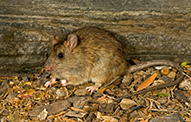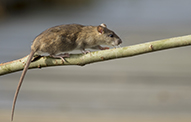Roof Rat Behavior
As their name indicates, roof rats usually nest high above ground in trees, tall overgrown shrubs, or dense vegetation such as ivy. Roof rats are excellent climbers and often access homes by running along tree branches, cables or wires. In buildings, roof rats typically nest in the upper part of structures in enclosed or elevated spaces such as attics, walls, false ceilings, and cabinets. They are very agile and can squeeze through openings only 1/2-inch wide. Roof rats can climb down to a food source.
Roof rats routinely travel up to 300 feet for food. They often can be seen at night running along overhead utility lines or fence tops. They have an excellent sense of balance and use their long tails to steady themselves while traveling along overhead utility lines. They move faster than Norway rats and are very agile climbers, which enables them to quickly escape predators.
Given their history of causing damage (gnawing through wiring, food contamination, etc.) and health problems (vectors for salmonella, murine typhus, etc.), it is important that homeowners understand how to identify roof rats and businesses understand how to protect themselves from these costly pests.




